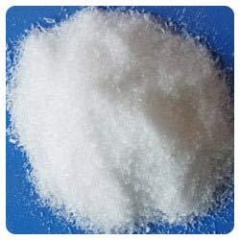Difference between revisions of "Citric Acid"
(→Shipment / Storage) |
|||
| Line 20: | Line 20: | ||
==Shipment / Storage== | ==Shipment / Storage== | ||
Citric acid; colourless, translucent crystals or powder; odourless, strongly acid taste. Very soluble in water and alcohol, soluble in [[ether]]. Combustible.<br><br> | Citric acid; colourless, translucent crystals or powder; odourless, strongly acid taste. Very soluble in water and alcohol, soluble in [[ether]]. Combustible.<br><br> | ||
| − | Citric acid is mostly packed in 25 kg or 1.000 kg [[ | + | Citric acid is mostly packed in 25 kg or 1.000 kg [[Bulk Bags]]. |
| + | |||
==Risk Factors== | ==Risk Factors== | ||
* Moisture (caking) | * Moisture (caking) | ||
Revision as of 14:19, 9 January 2013
| Infobox on Citric Acid | |
|---|---|
| Example of Citric Acid |  |
| Facts | |
| Origin | |
| Stowage factor (in m3/t) | |
| Humidity / moisture | |
| Ventilation | |
| Risk factors | See text |
Citric Acid
Description
Citric and lactic acids are produced by fermentation which utilized a carbohydrate source such as corn based starch and sugar beet molasses. Fermentation yields a crude purity product which requires further refining. One refining technique utilities a precipitation process, this process first uses lime to produce calcium citrate solids, this is then contacted with sulfuric acid which produces a partially purified soluble citric acid and calcium sulfate by product. Another technique used is solvent extraction. These processes produce streams which require demineralization by ion exchange.
Citric acid can be extracted from the juice of citrus fruits by adding calcium oxide (lime) to form calcium citrate, an insoluble precipitate that can be collected by filtration; the citric acid can be recovered from its calcium salt by adding sulfuric acid. Citric acid is obtained also by fermentation of glucose with the aid of the mold Aspergillus niger and can be obtained synthetically from acetone or glycerol.
Citric acid is a weak organic acid. It is a natural preservative/conservative and is also used to add an acidic, or sour, taste to foods and soft drinks. In biochemistry, the conjugate base of citric acid, citrate, is important as an intermediate in the citric acid cycle, and therefore occurs in the metabolism of virtually all living things. It can also be used as an environmentally benign cleaning agent. It can cause severe irritation to the skin and possible minor skin burns.
Citric acid exists in greater than trace amounts in a variety of fruits and vegetables, most notably citrus fruits. Lemons and limes have particularly high concentrations of the acid; it can constitute as much as 8% of the dry weight of these fruits (about 47 g/L in the juices). The concentrations of citric acid in citrus fruits range from 0.005 mol/L for oranges and grapefruits to 0.30 mol/L in lemons and limes. Within species, these values vary depending on the cultivar and the circumstances in which the fruit was grown.
At room temperature, citric acid is a white crystalline powder. It can exist either in an anhydrous (water-free) form or as a monohydrate. The anhydrous form crystallizes from hot water, while the monohydrate forms when citric acid is crystallized from cold water. The monohydrate can be converted to the anhydrous form by heating above 78°C. Citric acid also dissolves in absolute (anhydrous) ethanol (76 parts of citric acid per 100 parts of ethanol) at 15°C.
In chemical structure, citric acid shares the properties of other carboxylic acids. When heated above 175°C, it decomposes through the loss of carbon dioxide and water.
Citric acid is a slightly stronger acid than typical carboxylic acids because the anion can be stabilized by intramolecular hydrogen-bonding from other protic groups on citric acid.
Application
Preparation of citrates, flavouring extracts, confections, soft drinks, effervescent salts, acidifier, dispersing agent, medicines, acidulant and antioxidant in foods, sequestering agent, water-conditioning agent and detergent builder, cleaning and polishing stainless steel and other metals, alkyd resins, mordant, removal of sulfur dioxide from smelter waste gases, abscission of citrus fruit in harvesting, cultured dairy products.
It is a natural food preservative that is also used to add an acidic, or sour taste to foods and soft drinks. In biochemistry, it is important as an intermediate in the Krebs (citric acid) cycle and therefore occurs in the metabolism of virtually all living things. Citric acid can also be used as an environmentally benign cleaning agent.
Shipment / Storage
Citric acid; colourless, translucent crystals or powder; odourless, strongly acid taste. Very soluble in water and alcohol, soluble in ether. Combustible.
Citric acid is mostly packed in 25 kg or 1.000 kg Bulk Bags.
Risk Factors
- Moisture (caking)
- Contamination/defilement











